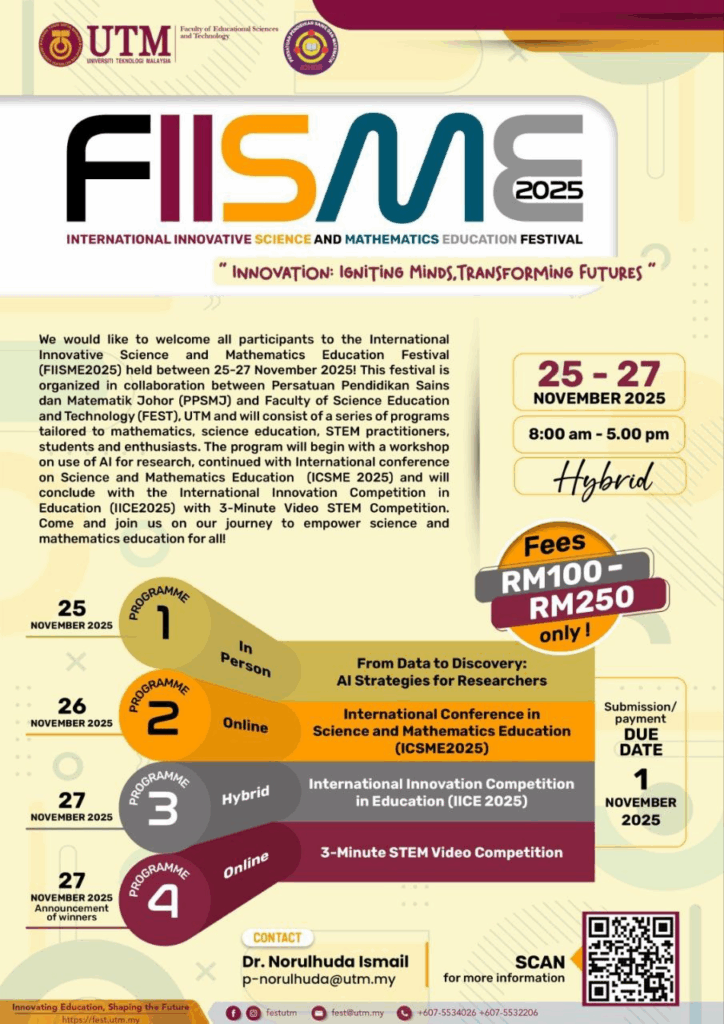𝙄𝙣𝙩𝙚𝙧𝙣𝙖𝙩𝙞𝙤𝙣𝙖𝙡 𝙄𝙣𝙣𝙤𝙫𝙖𝙩𝙞𝙫𝙚 𝙎𝙘𝙞𝙚𝙣𝙘𝙚 𝙖𝙣𝙙 𝙈𝙖𝙩𝙝𝙚𝙢𝙖𝙩𝙞𝙘𝙨 𝙁𝙚𝙨𝙩𝙞𝙫𝙖𝙡 2025
![]() Submission & Payment Due Date: 1 November 2025
Submission & Payment Due Date: 1 November 2025
![]() Contact: Dr. Norulhuda Ismail (p-norulhuda@utm.my)
Contact: Dr. Norulhuda Ismail (p-norulhuda@utm.my)
![]() More info: http://bit.ly/FIISME2025
More info: http://bit.ly/FIISME2025
𝐅𝐈𝐈𝐒𝐌𝐄 2025 – 𝐄𝐯𝐞𝐧𝐭 𝐃𝐞𝐬𝐜𝐫𝐢𝐩𝐭𝐢𝐨𝐧
We would like to welcome all participants to the International Innovative Science and Mathematics Festival 2025 held between 25-27 November 2025. This festival is organized in collaboration between 𝐅𝐚𝐜𝐮𝐥𝐭𝐲 𝐨𝐟 𝐄𝐝𝐮𝐜𝐚𝐭𝐢𝐨𝐧𝐚𝐥 𝐒𝐜𝐢𝐞𝐧𝐜𝐞𝐬 𝐚𝐧𝐝 𝐓𝐞𝐜𝐡𝐧𝐨𝐥𝐨𝐠𝐲 (𝐅𝐄𝐒𝐓), 𝐔𝐓𝐌 and 𝐏𝐞𝐫𝐬𝐚𝐭𝐮𝐚𝐧 𝐏𝐞𝐧𝐝𝐢𝐝𝐢𝐤𝐚𝐧 𝐒𝐚𝐢𝐧𝐬 𝐝𝐚𝐧 𝐌𝐚𝐭𝐞𝐦𝐚𝐭𝐢𝐤 𝐉𝐨𝐡𝐨𝐫 (𝐏𝐏𝐒𝐌𝐉). To participate in this program, you may choose any of these following programs.
1️. 𝐅𝐫𝐨𝐦 𝐃𝐚𝐭𝐚 𝐭𝐨 𝐃𝐢𝐬𝐜𝐨𝐯𝐞𝐫𝐲: 𝐀𝐈 𝐒𝐭𝐫𝐚𝐭𝐞𝐠𝐢𝐞𝐬 𝐟𝐨𝐫 𝐑𝐞𝐬𝐞𝐚𝐫𝐜𝐡𝐞𝐫𝐬
![]() 25 November 2025 | In-Person
25 November 2025 | In-Person
A practical workshop designed for academics, researchers, and postgraduate students to explore effective ways of integrating AI into the research process. Learn how to leverage AI for data analysis, literature review, and knowledge discovery to boost productivity and innovation.
2️. 𝐈𝐧𝐭𝐞𝐫𝐧𝐚𝐭𝐢𝐨𝐧𝐚𝐥 𝐂𝐨𝐧𝐟𝐞𝐫𝐞𝐧𝐜𝐞 𝐢𝐧 𝐒𝐜𝐢𝐞𝐧𝐜𝐞 𝐚𝐧𝐝 𝐌𝐚𝐭𝐡𝐞𝐦𝐚𝐭𝐢𝐜𝐬 𝐄𝐝𝐮𝐜𝐚𝐭𝐢𝐨𝐧 (𝐈𝐂𝐒𝐌𝐄 2025)
![]() 26 November 2025 | Online
26 November 2025 | Online
A global platform for STEM educators, researchers, and practitioners to share research findings, innovative teaching approaches, and best practices. This conference fosters knowledge exchange to advance science and mathematics education in diverse educational contexts.
3️. 𝐈𝐧𝐭𝐞𝐫𝐧𝐚𝐭𝐢𝐨𝐧𝐚𝐥 𝐈𝐧𝐧𝐨𝐯𝐚𝐭𝐢𝐨𝐧 𝐂𝐨𝐦𝐩𝐞𝐭𝐢𝐭𝐢𝐨𝐧 𝐢𝐧 𝐄𝐝𝐮𝐜𝐚𝐭𝐢𝐨𝐧 (𝐈𝐈𝐂𝐄 2025)
![]() 27 November 2025 | Hybrid
27 November 2025 | Hybrid
An exciting competition where educators, innovators, and students present creative, impactful solutions that enhance teaching and learning. Participants showcase their projects to a panel of judges, aiming to inspire and transform educational practices.
4️. 3-𝐌𝐢𝐧𝐮𝐭𝐞 𝐒𝐓𝐄𝐌 𝐕𝐢𝐝𝐞𝐨 𝐂𝐨𝐦𝐩𝐞𝐭𝐢𝐭𝐢𝐨𝐧
![]() 27 November 2025 | Announcement of winners
27 November 2025 | Announcement of winners
Submit your STEM video that is 3 minutes in length. Competition is open for individuals or in groups. This competition promotes public engagement with science and encourages innovative approaches to science communication.


